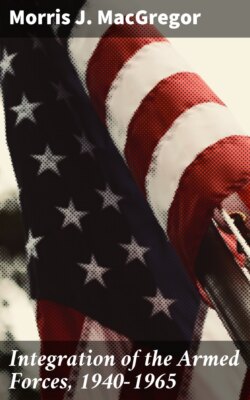Читать книгу Integration of the Armed Forces, 1940-1965 - Morris J. MacGregor - Страница 32
На сайте Литреса книга снята с продажи.
ОглавлениеGun Crew of the 52d Defense Battalion
on duty, Central Pacific, 1945.
The experience of the two defense battalions demonstrates that racial consideration governed their eventual deployment just as it had decided their organization. With no further strategic need for defense battalions, the Marine Corps began to dismantle them in 1944, just as the two black units became operational and were about to be sent to the Central and South Pacific. The eighteen white defense battalions were subsequently reorganized as antiaircraft artillery battalions for use with amphibious groups in the forward areas. While the two black units were similarly reorganized, only they and one of the white units retained the title of defense battalion. Their deployment was also different. The policy of self-contained, segregated service was, in the case of a large combat unit, best followed in the rear areas, and the two black battalions were assigned to routine garrison duties in the backwaters of the theater, the 51st at Eniwetok in the Marshalls, the 52d at Guam. The latter unit saw nearly half its combat-trained men detailed to work as stevedores. It was not surprising that the morale in both units suffered.[4–31]
Even more explicitly racial was the warning of a senior combat commander to the effect that the deployment of black depot units to the Polynesian areas of the Pacific should be avoided. The Polynesians, he explained, were delightful people, and their "primitively romantic" women shared their intimate favors with one and all. Mixture with the white race had produced "a very high-class half-caste," mixture with the Chinese a "very desirable type," but the union of black and "Melanesian types … produces a very undesirable citizen." The Marine Corps, Maj. Gen. Charles F. B. Price continued, had a special moral obligation and a selfish interest in protecting the population of American Samoa, especially, from intimacy with Negroes; he strongly urged therefore that any black units deployed to the Pacific should be sent to Micronesia where they "can do no racial harm."[4–32]
General Price must have been entertaining second thoughts, since two depot companies were already en route to Samoa at his request. Nevertheless, because of the "importance" of his reservations the matter was brought to the attention of the Director of Plans and Policies.[4–33] As a result, the assignment of the 7th and 8th Depot Companies to Samoa proved short-lived. Arriving on 13 October 1943, they were redeployed to the Ellice Islands in the Micronesia group the next day.
Thanks to the operations of the ammunition and depot companies, a large number of black marines, serving in small, efficient labor units, often exposed to enemy fire, made a valuable contribution. That so many black marines participated, at least from time to time, in the fighting may explain in part the fact that relatively few racial incidents took place in the corps during the war. But if many Negroes served in forward areas, they were all nevertheless severely restricted in opportunity. Black marines were excluded from the corps' celebrated combat divisions and its air arm. They were also excluded from the Women's Reserve, and not until the last months of the war did the corps accept its first black officer candidates. Marine spokesmen justified the latter exclusion on the grounds that the corps lacked facilities—that is, segregated facilities—for training black officers.[4–34]
These exclusions did not escape the attention of the civil rights spokesmen who took their demands to Secretary Knox and the White House.[4–35] It was to little avail. With the exception of the officer candidates in 1945, the separation of the races remained absolute, and Negroes continued to be excluded from the main combat units of the Marine Corps.
Crewmen of USCG Lifeboat Station, Pea Island, North Carolina,
ready surf boat for launching.
Personal prejudices aside, the desire for social harmony and the fear of the unknown go far toward explaining the Marine Corps' wartime racial policy. A small, specialized, and racially exclusive organization, the Marine Corps reacted to the directives of the Secretary of the Navy and the necessities of wartime operation with a rigid segregation policy, its black troops restricted to about 4 percent of its enlisted strength. A large part of this black strength was assigned to labor units where Negroes performed valuable and sometimes dangerous service in the Pacific war. Complaints from civil rights advocates abounded, but neither protests nor the cost to military efficiency of duplicating training facilities were of sufficient moment to overcome the sentiment against significant racial change, which was kept to a minimum. Judged strictly in terms of keeping racial harmony, the corps policy must be considered a success. Ironically this very success prevented any modification of that policy during the war.
